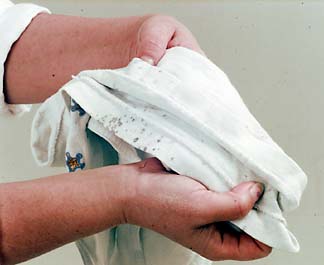


Culprit of
mystery stains
tough to spot
That wooden closet could
By Treena Shapiro
be leaving nasty marks
on your clothes
Star-BulletinCONCERNED reader Pattie Komura was clearing out her closet and was shocked to find some of her outfits covered in little rust-colored spots.
The pattern looked as if she had dropped something on the floor and it had spattered up on her, one of Komura's co-workers said. But some of the garments had never been worn.
Komura's apartment is air-conditioned, she keeps her draperies drawn and she uses plastic hangers, so she wondered what might have caused the stains. She called us for help, but our staff couldn't give her much advice. We, too, have been puzzled by spotty clothes, only to write them off as lost causes. Our solution has been to donate the clothes to charities in hope that they would know how to clean them up and make them wearable for someone else.
Komura wasn't ready to give up on an expensive linen outfit.
"Closet stains," said Al Phillips-Ala Moana Center cleaner and spot specialist Wilfredo Madayad upon seeing the stains in question.
Cockroaches, a damp environment, human discharges from wear such as perspiration and oil, salt and fumes in the environment all contribute to mysterious stains, Madayad said.
Barbara Harger, an associate professor at the University of Hawaii and Chair of the Department of Human Resourses, suspects that Komura's culprit is a fungus, because of similar stains reported by people who work with paper.
Harger, who specializes in textile science, said that the only remedy she has found for these stains is sunlight. Of course, leaving clothes out in the sun could create a different type of damage, causing garments to fade or become discolored.
Sugars may also result in unexpected staining, according to Harger. Beverages spilled on fabric may not be visible once they dry, but exposure to heat or a period without washing can cause caramelization or oxidation of the sugar, resulting in brown or yellow stains.
Also, a gift of a white flower lei -- plumeria, pikake, tuberose -- can leave a permanent reminder of the sentiment, brown or yellow stains around the neck and shoulders.
Craig Kurosu, owner of Clyde's Cleaners on King Street, offered several more explanations for fabric discoloration.
One problem that plagues Hawaii clothing is humidity, which causes yellow stains to appear on fabric.
Staining can also occur if a garment is not cleaned after it has been worn, allowing bacteria to grow on the dirt. "Cleaning it is like preservation," Kurosu said.
Light, either ultraviolet rays from the sun or fluorescent lighting, can also cause discoloration. This why clothing stores rotate their stocks frequently, Kurosu explained. The rotation helps keep the colors intact.
The closet itself can cause spotting and streaking if it is made out of wood. Wood secretes acids that can be transferred to the clothing.
Insects are also a frequent source of damage. If moths, cockroaches and silverfish lay eggs on the fabric, their hatching, growing larvae can leave markings on the material.
Kurosu said that he has had some success at removing these sorts of stains. The results depend on the construction and color-fastness of the fabric. Cotton offers the best chances for stain-removal and Kurosu has been able to clean some rayon. With silk, however, he said that the stains are generally permanent.
Carl Patton, sales manager at Hakuyosha Hawaii, Inc., on Sheridan Street, said that stains on stored clothing are often the result of oxidation. Pollutants in the air can settle on fabric, creating yellow, brown and rust-colored spots.
Patton also said the stains can be difficult to remove, depending on the fabric, the color of the fabric and type of dye used.
The best way to prevent these stains, Kurosu said, is to wear clothes frequently. If you're not wearing a garment, you have to ask yourself why you're keeping it.
Some garments, such as wedding gowns and antique kimono or vintage dresses may be keepsakes that are not intended to be worn often. In these cases, Kurosu recommends wrapping the garment in acid-free tissue and storing it in a cedar chest. The cedar will keep insects away and the acid-free paper will protect the fabric from acids in the wood.
Click for online
calendars and events.